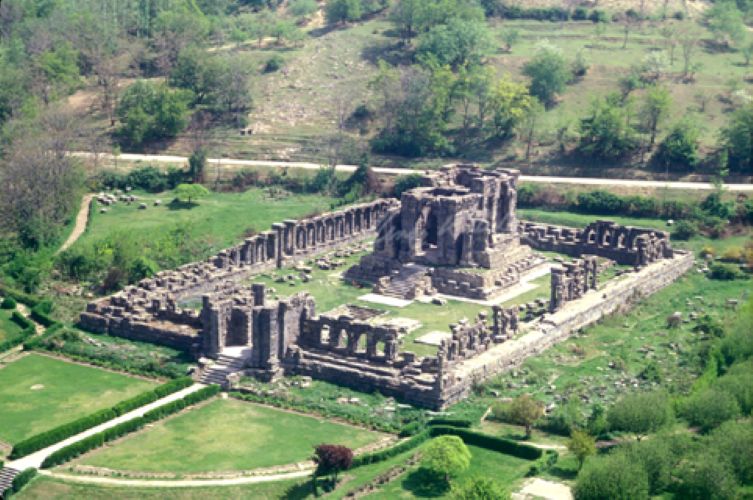THE ART OF VERDANT HIMALAYAS

The Sun Temple of Martand
Benoy K Behl
In the high Himalayan mountains is the verdant valley of Kashmir. Amidst its great natural beauty, the thoughts of man have constantly turned to the wonder of creation. Since early times, Kashmir has been a renowned centre of Hindu and Buddhist philosophy.
It is here that the Indian philosophy of aesthetics was expounded in detail by the philosopher Abhinavagupta in the 10th century. It is in Kashmir that Shaivism developed to great heights. The manifestation of Shiva in the beauty of the world around us was worshipped as Shakti. Unlike earlier austere forms of Buddhism, the Mahayana and Vajrayana schools flourished here. There is a very special quality of joyousness which pervades the art of this land which is blessed by the bounty of nature.
In the 1st century, the Kushana emperor Kanishka held the Fourth Great Buddhist Council in Kashmir. It was here that Sanskrit first became a language of Buddhist scriptures instead of Pali which was used before. This was also the first time that Mahayana Buddhism received major royal patronage. Earlier Buddhism was mainly an ethical message, which called upon each person to seek his own salvation through self-discipline. The new form of Buddhism brought the concept of Bodhisattvas. These were beings who had postponed their own salvation to help others in the world, on the path towards enlightenment. Followers could turn to them and pray for help. This form of Buddhism proved very popular and spread northwards and eastwards from Kashmir, to Central Asia, China and Tibet.
The site of Harwan, on a hill near Srinagar, is where the Fourth Buddhist Council is believed to have been held. Tiles found here of a little later period, about the 4th century, display a remarkable meeting of cultures. We see here the art of the Gupta period in the plains of North India interacting with influences from Central Asia. Geese have been a common motif in Indian art since the Mauryan period. Figures made in balconies above, appeared in the art of the Western Indian caves in the 1st century BC and were well established in Kushana art soon thereafter. The facial features seen in the figures, their dress and other motifs remind us of the Parthians, Sassanians and Scythians whose presence was constantly felt in Kashmir. In the naturalistic expressions and physiognomy, we see the influence of the art of Gandhara.
The 8th century ushered in a glorious period in Kashmir. According to the 12th century historian Kalhana, king Lalitaditya expanded the kingdom and conquered most of north India. These military adventures are more likely to have been major raids rather than conquests. However, Lalitaditya would have carried back with him inestimable treasures of precious stones and gold. The prosperity of his reign is seen in the exuberant monuments and art of this period.
Under the Glimpses of Culture series, India Habitat Centre presents an online talk and screening of the film ‘Art of the Verdant Himalayas’ produced by Benoy K Behl for Doordarshan on November 23, 6pm

